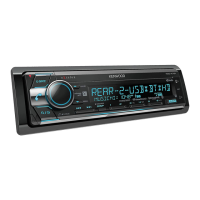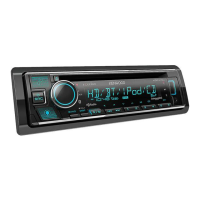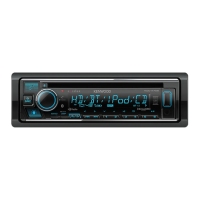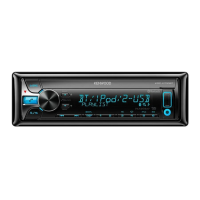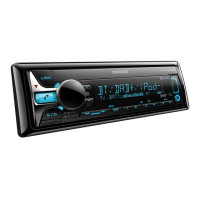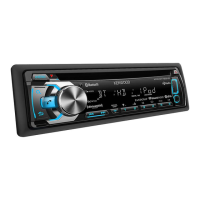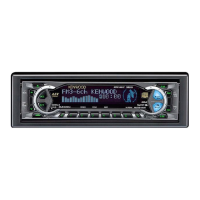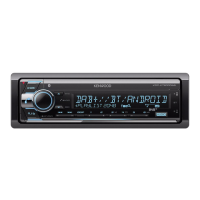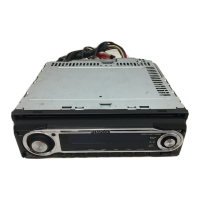
Do you have a question about the Kenwood KDC-X7016L and is the answer not in the manual?
| RDS | Yes |
|---|---|
| CD Player | Yes |
| MP3 Playback | Yes |
| CD-R/CD-RW Playback | Yes |
| Display Type | LCD |
| Pre-out Ports | 3 (Front, Rear, Subwoofer) |
| Subwoofer Out | Yes |
| Remote Control | Yes |
| Channels | 4 |
| Max Power Output | 50W x 4 |
| WMA Playback | Yes |
| AAC Playback | Yes |
| Display Illumination | Variable Colour |
| AUX Input | Yes |
| USB Port | Yes |
| Steering Wheel Control | Yes |
| Equalizer | 13-band |
Essential warnings to prevent injury or fire during operation.
Steps to reset the unit to factory settings if it fails.
Guidelines for cleaning the unit, faceplate, and handling terminals.
Proper handling and types of CDs that can be used or not used.
Description of buttons, knobs, AUX input, and USB terminal on the unit's front panel.
Details about the included microphone for hands-free calls and voice recognition.
How to disable the initial demonstration mode.
Turning the unit on/off and switching audio sources.
General procedure for navigating and using menu settings.
Connecting and playing music from an iPod.
Selecting songs by category like artist, album, or genre.
Settings for random, repeat, and other playback modes.
Using the iPod's own controls for playback.
Configuration options for iPod connectivity and features.
Overview of different search methods for iPod content.
Searching iPod content by specific criteria like artist or album.
Finding music similar to the currently playing track.
Searching iPod content alphabetically by character.
Adjusting skip ratios for music playback on iPod.
Registering, playing, and deleting songs from a custom playlist.
Continued management of custom playlists, including deletion.
Connecting and playing music files from a USB device.
Searching for music files on a USB device by category.
Setting playback modes like random and repeat for USB files.
Configuration options for USB connectivity and features.
Adjusting skip ratios for music files on a USB device.
Using the remote control to search for music on USB.
Faceplate removal, disc insertion, and CD source selection.
Searching for music tracks on a CD.
Setting playback modes for music CDs and audio files.
Basic operations for an optional disc changer.
Using the remote control for CD music search.
Using the remote control for disc changer operations.
Choosing the tuner source and receiving band (FM/AM).
Manual and automatic station tuning procedures.
Configuration options for tuner operation and reception.
Storing and recalling favorite radio stations.
Automatically storing the strongest radio stations.
Recalling previously stored radio stations.
Tuning directly via frequency using the remote control.
Adjusting tuning frequency increments for FM and AM bands.
Selecting TV source, band, video input, and channels.
Storing and recalling favorite TV channels.
Tuning TV channels directly using the remote control.
Steps for initial Bluetooth device connection and pairing.
Choosing Bluetooth Audio as the playback source.
Playing and pausing music content via Bluetooth.
Searching for music tracks over a Bluetooth connection.
Initial setup for phone connectivity and hands-free operation.
Managing incoming and ongoing phone calls.
Handling multiple incoming calls while on an active call.
Switching modes and adjusting volume during a call.
Switching between current and waiting calls.
Initiating phone calls from the unit using various methods.
Using pre-registered numbers for quick dialing.
Dialing numbers stored in the phone book.
Dialing numbers from the unit's call history.
Manually entering a phone number for dialing.
Making calls using voice commands and voice tags.
Adding numbers to the speed dial list for quick access.
Cycling through different display layouts like 5-line, 3-line, and iPod-like.
Enabling text scrolling for long titles or information.
Various display customization settings like dimmer and contrast.
Customizing 5-line, 3-line, and iPod-like display modes.
Continued customization of 5-line, 3-line, and iPod-like display modes.
Choosing which text elements to display for various sources.
Adjusting the spectrum analyzer visualization modes and settings.
Customizing panel and key illumination colors.
Configuring display information for auxiliary input sources.
Setting the unit's internal clock and date.
Initial configuration options like source selection and beep settings.
Turning the unit's demonstration mode on or off.
How audio mutes automatically when a call is received.
Instructions for safely removing the detachable faceplate.
Instructions for safely reattaching the detachable faceplate.
Adjusting parameters like subwoofer, DSP, equalizer, and sound effects.
Configuring independent audio output for front and rear zones.
Choosing from pre-defined equalizer sound profiles.
Customizing equalizer bands manually.
Optimizing sound based on seating position.
Detailed fine-tuning of speaker output based on position.
Further settings for the dual zone audio system.
Adjusting sound based on vehicle interior for optimal acoustics.
Configuring speaker size and location for crossover settings.
Fine-tuning sound compensation based on car type.
Adjusting crossover frequencies for different speakers.
Saving custom audio settings configurations as presets.
Loading previously saved audio settings.
Saving frequently used functions or settings for quick access.
Accessing previously saved favorite settings.
Removing saved favorite functions or settings.
General settings for Bluetooth features like auto-answer and output.
The process of pairing a new Bluetooth device with the unit.
Continued steps for pairing Bluetooth devices.
Pairing devices that may not register through the standard process.
Setting or changing the Bluetooth PIN code for pairing.
Choosing which paired device to connect for audio or phone.
Removing paired devices from the unit's memory.
Transferring contacts from a phone to the unit.
Creating voice tags for names for voice dialing.
Creating voice tags for phone number categories for voice dialing.
Transferring text messages from phone to unit for viewing.
Viewing received text messages on the unit's display.
Remote control functions for radio tuning and selection.
Remote functions for USB, CD, and audio file playback.
Remote control functions for iPod operation.
Common remote functions like volume, source selection, and navigation.
Remote functions for managing phone calls.
Initial setup and battery replacement for the remote control.
Details on playable audio file formats, disc media, and file structure.
List of supported Apple devices and connection cable requirements.
Details and requirements for connecting USB devices.
Information about the KENWOOD Music Editor Lite software.
Supported Bluetooth profiles for cell phones.
Supported Bluetooth profiles for audio players.
A list of common and source-specific menu items.
Continuation of menu item listings for different sources.
Explanations of symbols shown on the unit's display.
Basic advice for resolving common operational issues.
Troubleshooting problems related to Tuner, Disc, and Audio Files.
Troubleshooting problems with phone calls and Bluetooth audio.
Decoding common error codes and messages displayed by the unit.
Further explanations of error indicators and messages.
Technical details for the FM and AM tuner sections.
Technical details for the Bluetooth module and profiles.
Technical details for USB interface and CD player.
Technical details for audio output and auxiliary input.
General electrical and physical specifications of the unit.

